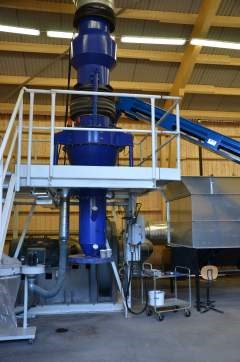Dryer pilot

Novel dryer pilots have recently been installed at the Biofuel Technology Centre (BTC) at SLU. The facility currently includes two different installations for drying biomass. SLU, SBT is thus now commencing research with these installations at BTC in cooperation with SP Processum, the Swedish Energy Agency, the Kempe Foundations and Airgrinder AB.
Belt dryer
One of the current installations is a belt dryer for, e.g., saw dust and wood chips, where material can be dried continuously on an air-permeable wire cloth in three different sections.
The sections are located on top of each other and the wire cloth rotates as a conveyor belt between large rollers. Material is fed in from the top part of the dryer and moves down wards on the wire cloth section by section. After the last section material is released from the bottom of the dryer and is lifted with the help of a scoop elevator to be collected in large transportation sacks.
Drying air is provided by the help of fan from the other side of the dryer and after passing through the material beds on the wire cloth is directed out alongside the other side of the dryer. Drying air is heated through the combustion of pellets/wood chips in a 500 kW heating unit.
Dryer dimensions are approx. 5 x 2m with a capacity of circa 3-5 m3 dry material per hour. The pilot is a prototype under cooperative development by BTC and the supplier.
Tornado dryer
The other installation is a so-called Tornado dryer (Airgrinder 3455NH), particularly suitable for drying sludge and other challenging materials which are, e.g., prone to agglomerate during drying. Material can be fed in through a cell feeder or a screw pump and is transport with the drying air medium into a cyclone.
In the cyclone the material gains a high velocity with the drying air medium created by a high-capacity fan. Through increased particle velocity the material disintegrates with a retention time of only a few seconds. Simultaneously a separation based on particle size takes place. Smaller material fractions continue further and are captured in a bag-house filter unit located outside the building. Larger particles are collected below the cyclone. Distribution between the particle size fractions can be regulated as needed.
Heating of drying air is performed with the 500 kW heating unit. The dryer can, e.g., be used in large process industries where substantial amounts of secondary energy in the form of waste heat are potentially available. With the pilot available secondary energy is simulated through the heating unit.